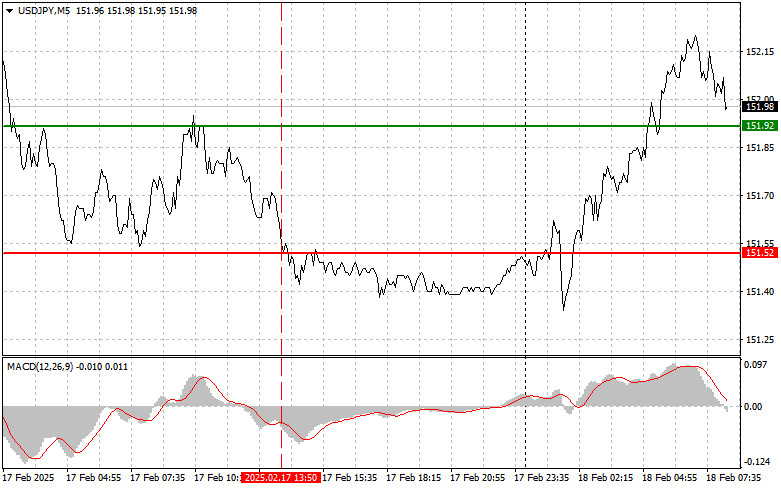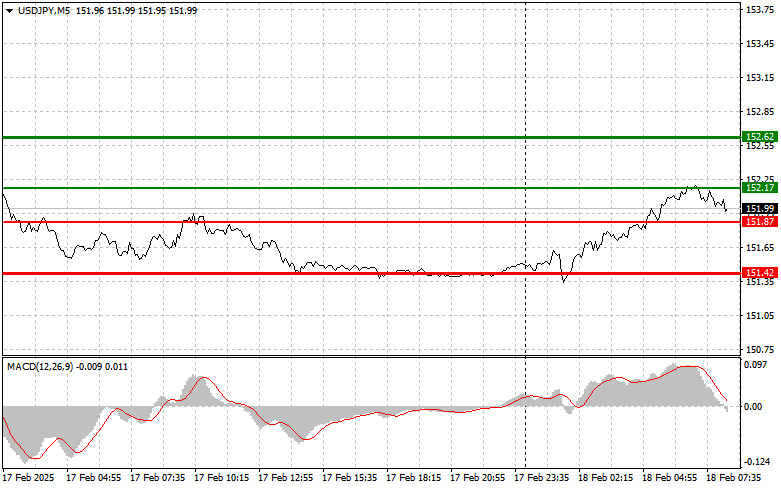Analysis of Trades and Trading Tips for the Japanese Yen
The test of the 151.52 price level occurred when the MACD indicator had already moved significantly below the zero mark, limiting the pair's downside potential. For this reason, I chose not to sell the dollar.
During Asian trading, the dollar strengthened considerably, bolstered by comments from Federal Reserve official Christopher Waller. He stated that recent economic data supports keeping interest rates unchanged. According to Waller, the winter slowdown allows for a cautious evaluation of the future direction of monetary policy. He emphasized that only if inflationary pressures ease would it be appropriate to discuss any further policy easing. This statement reinforced the dollar's position.
The Japanese yen, highly sensitive to interest rate differentials between Japan and the U.S., came under renewed pressure. The Bank of Japan is in no rush to adjust its policy toward rate hikes, maintaining the dollar's attractiveness. If strong U.S. economic data continues to be released and the Federal Reserve holds its hawkish stance, the dollar may continue to appreciate, exerting further downward pressure on the yen.
Regarding the intraday strategy, I will focus more on implementing Scenario #1 and Scenario #2.
Buy Signal
Scenario #1: I plan to buy USD/JPY today when the entry price reaches 152.17 (green line on the chart), targeting 152.62 (thicker green line). Around 152.62, I intend to exit buy trades and open sell positions in the opposite direction (expecting a 30-35 pip retracement from this level). The best strategy for buying the pair is to return on pullbacks and significant declines in USD/JPY. Important! Before buying, ensure the MACD indicator is above the zero mark and starting to rise.
Scenario #2: I also plan to buy USD/JPY today in case of two consecutive tests of the 151.87 price level when the MACD indicator is in the oversold zone. This will limit the pair's downside potential and lead to a market reversal to the upside. Growth toward 152.17 and 152.62 can be expected.
Sell Signal
Scenario #1: I plan to sell USD/JPY today only after a break below 151.87 (red line on the chart), which should lead to a rapid decline. The key target for sellers will be 151.42, where I intend to exit sell trades and immediately open buy positions in the opposite direction (expecting a 20-25 pip retracement). Pressure on the pair could return any time during the first half of the trading session. Important! Before selling, make sure the MACD indicator is below the zero mark and starting to decline from it.
Scenario #2: I also plan to sell USD/JPY today in case of two consecutive tests of the 152.17 price level when the MACD indicator is in the overbought zone. This will limit the pair's upside potential and lead to a market reversal downward. A decline toward 151.87 and 151.42 can be expected.
What's on the Chart:
- The thin green line represents the entry price where the trading instrument can be bought.The thick green line indicates the expected price level where a Take Profit order can be placed, or profits can be manually secured, as further price growth above this level is unlikely.The thin red line represents the entry price where the trading instrument can be sold.The thick red line indicates the expected price level where a Take Profit order can be placed, or profits can be manually secured, as further price decline below this level is unlikely.The MACD indicator should be used to assess overbought and oversold zones when entering the market.
Important Notes:
- Beginner Forex traders should exercise extreme caution when making market entry decisions. It is advisable to stay out of the market before the release of important fundamental reports to avoid exposure to sharp price fluctuations. If you choose to trade during news releases, always use stop-loss orders to minimize potential losses. Trading without stop-loss orders can quickly wipe out your entire deposit, especially if you neglect money management principles and trade with high volumes.
- Remember, successful trading requires a well-defined trading plan, similar to the one outlined above. Making impulsive trading decisions based on the current market situation is a losing strategy for intraday traders.














